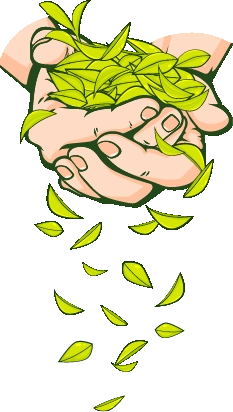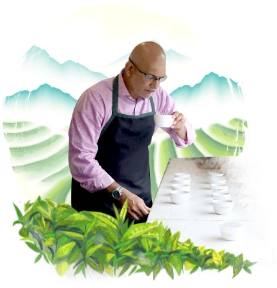An Ode to Summer And……The Second (to none) Flush in Darjeeling
Darjeeling always evokes mystique, mystery and magic. The crisp, clean air, the misty clouds, the mighty mountains – and its most famous product – Darjeeling tea! What Champagne is to sparkling wine, Roquefort is to blue cheese, Scotch is to whisky and Havana is to cigars, Darjeeling is to Tea!
Darjeeling Tea is the Champagne of Teas – the iconic and enigmatic gem among all teas, and certainly, one of the most expensive and sought after teas in the world – from the Emperor of Japan to the Chancellor of Germany.
So exclusive and rare is Darjeeling Tea that only 87 fabled tea estates in the defined Darjeeling region on the foothill of the Himalayas are certified by the Tea Board of India as producing authentic Darjeeling Tea. The combined area under cultivation at these 87 estates is roughly 48,000 acres – about the same size as the Queen’s Balmoral Estate. It is in these chosen and select slopes between 700 and 7000 ft above the sea level that light sun, cool air, plentiful rainfall and rich soil are brought together by Mother Nature to create the magic of Darjeeling Teas. No other region in the world can produce this magic, and that is why Darjeeling Tea is so unique.
Darjeeling Black Orthodox Tea is the first Indian product to have the GI protection way back in 2004-5. In October 2019, Darjeeling Green Tea and Darjeeling White Tea also received the GI tag.
And yet, like all things exclusive, Darjeeling Tea remains a ‘riddle wrapped in mystery inside an enigma’! There is so much mystery and mystique and magic to Darjeeling Tea. From Muscatel to Moonlight, from Silver Needles to Golden Pekoe, and from Flush to Flavour, every aspect of Darjeeling Tea is a story unto itself.
In this blog, we retell the fascinating story of the Darjeeling Second Flush teas…or as many tea connoisseurs call it – the Second-to-none Flush tea!
What is a Flush
A Flush refers to plucking cycle. Typically, the tea bushes are plucked very 8-10 days, depending on climatic conditions. It is only the top leaves and buds that are freshly sprung during the week that are plucked, and the rest of the leaves and the bush are not disturbed in any way.
When we talk about Flushes, it is important to remember that Darjeeling is situation in the foothills of the might Himalayas and tea is grown along the slopes at an altitude for 2000ft to 7000ft. During the winter months, typically from November to end of March, the weather is simply too cold, and the tea bushes go into what is called ‘winter hibernation’. There is no plucking or manufacturing, and as the planters say, the bushes are enjoying their well-earned rest and sleep. With the arrival of Spring, the temperature starts rising and fresh showers signal the sleeping bushes to awake! The bushes, fresh from their ‘well-earned rest and sleep” are refreshed and rejuvenated, and produce young, tender, fresh leaves and buds – the first of the season. Tea plucked during this period is called the First Flush. The best First Flush teas are made over a period of 3 weeks to 4 weeks, depending on how favourable the weather conditions are.
First Flush teas are characterised by their bright green leaves and silvery tips, and have a light-bodied cup with a delicate floral flavours.
Second Flush refers to the teas plucked in Summer, typically from 21st May every year – International Tea Day (21st May was particularly chosen as it heralds the beginning of the best season of tea). Second Flush is the time when the elusive and rare Muscatel teas are also made at select teas estates in Darjeeling.
Compared to the First Flush, Second Flush teas from Darjeeling are more full-bodied and intense, darker and mellower, and have a distinct Fruity flavour and a pleasant astringency laced with sweetness. Muscatel teas are intensely rich and fruity, with amazing layers of complex flavours that are very similar to the sweet Muscat grapes – and hence, the name.
While the First and the Second Flush are the two most important flushes in Darjeeling, it does not mean that the leaves are plucked for only for the first if second time! Second Flush simply means the second distinct season or phase of plucking. In other words, tea bushes may be plucked 5-6 times during May/June and all teas plucked during this time is collectively referred to as Second/Summer Flush.
Characteristics of Second Flush Teas
Darjeeling Second Flush Black teas are dark-tan and coppery, well-twisted and well-rolled, with a good profusion of golden tips. The leaves have a distinctly toasty, woody aroma with hues of sweetness. The liquor is bright and golden, vibrant and cheerful. The taste is smooth and mellow, full-bodied and sweetly astringent, but never bitter or harsh – the signature notes of any excellent Second Flush Darjeeling Tea. There are layers of fruity hues – grapefruit, figs, prunes and tangerines, all enveloped in a sweet covering of orchid like flavor and a lingering woody finish.
Muscatel Teas
Produced only for a short span of ten days to two weeks in May/June during the famed Second Flush period in select Darjeeling tea estates, Muscatel teas evoke sweetest memories – just like shortest love evokes sweetest memories.
The Magic and the Mystery…and the Myth!
Much like Cinderella’s magical hour, Mother Nature’s magic at select Darjeeling tea estates also happens for a brief ten-day to two-week period in late summer – end May to mid-June. What makes Muscatel teas so elusive, almost ephemeral, is their uncertainty and the unpredictability. An estate can produce finest Muscatel teas this year, and next year, the magic can completely bypass it.
Here is now nature’s magic combines with human genius to produce this mercurial, magical and mythical tea :
The hot, humid and rainy climate in late summer in Darjeeling causes a rapid rise in infestation. Small insects and flies thrive on the rich flora and fauna during this period, which is also the peak Second Flush period in Darjeeling tea estates. Green insects called Jassids and Thrips appear abundantly around the tea plants. While they are definitely pests, they are vital catalysts for producing the Muscatel flavour.
Greenish in colour, they are like leaf-hoppers, just about a tenth of an inch in size. They feed upon the tender buds and leaves of the tea-bush, feasting on the rich sap. As they suck out this sap, the moisture content in leaves reduces, causing them to get stunted, shrivel and curl. Also, due to the many tiny needle-points created by these insects on the tea leaves, natural fermentation occurs even though the leaves are not yet plucked. With lesser moisture content, the flavours get concentrated, and the green leaf starts turning yellow. A chemical compound called Terpene is also produced within the tea leaves and buds. During the oxidations (fermentation) process, it is this compound Terpene that creates the unique Muscatel flavour.
And yet, there are some planters who will dismiss this explanation outright! They regard this explanation as a myth. While they concede teas made during the second flush period that are affected by Jassids, do make exceptional teas with distinct fruity notes, they still do not and should not qualify as true Muscatel teas. They believe that pure Muscatel teas are produced only from authentic Chinary bushes without intervention or infestation of insects. For them, it is the combination of nature’s quirk and human skill that creates this most enigmatic of teas.
Characteristics of Muscatel Teas
Pure Muscatel flavour ranges intense, sweet and fruity. From the whiff of woody cedar to perfumed peaches to spiced honey, a Muscatel tea can contain all these notes. When brewed properly, it has amber liquor (yellowish orange or orangish yellow) with a very positive and sweet ‘nose’ and a mellow to mild astringency. When stored properly, Muscatel teas are like wine, and get better as they mature, tasting more intense and adding layers of flavours.
The First Muscatel Tea
The first Muscatel tea was produced at the world-famous Castleton Tea Estate in 1985. The credit goes to the then factory manager of the estate, Mr. Arun Kumar Gomden. He noticed in June of 1985 that the teas produced had a very peculiar and intense flavour, which was quite unlike and different from the normal flavoury teas produced during the time. Upon tasting these, he found that they had a distinct fruity flavour, rich and intense that lingered on the palate. It reminded him of the rich, intense flavour of the Muscat grapes, used for making fine wines. He named this batch of teas, Muscatel – like Muscat grapes. Since then, Castleton Muscatel teas have won top awards and honours internationally, not to mention world-record prices. In 1992, a lot of Castleton FTGFOP1 Muscatel tea was sold for Rs. 13,0001 per kg. at the Calcutta tea auction.

Tea is a religion in the art of life.

